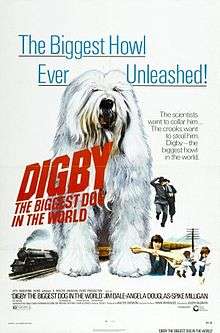Digby, the Biggest Dog in the World
| Digby, the Biggest Dog in the World | |
|---|---|
 | |
| Directed by | Joseph McGrath |
| Produced by |
Walter Shenson Executive producer Irwin Margulies |
| Written by |
Charles Isaacs Ted Key (novel) Michael Pertwee |
| Starring |
Jim Dale Angela Douglas Spike Milligan |
| Narrated by | Ted Key |
| Music by | Edwin Astley |
| Cinematography | Harry Waxman |
| Edited by | Jim Connock |
Production company |
Walter Shenson Films |
| Distributed by |
Twentieth Century Fox (UK) Cinerama Releasing Corporation (US) |
Release dates | 1973 |
Running time | 88 min |
| Country | United Kingdom |
| Language | English |
Digby, the Biggest Dog in the World is the title character of a British children's film with dollops of unexpected satire and comedy released in 1973 starring Jim Dale, and directed by Joseph McGrath. A large supporting cast of British movie stalwarts includes Spike Milligan, Angela Douglas, Norman Rossington, Milo O'Shea, Dinsdale Landen and Victor Spinetti. The production included composer Edwin Astley and cinematographer Harry Waxman. The film was based on the novel The Biggest Dog in the World by Ted Key.
The film starred Fernville Lord Digby in the title role. Digby was then the reigning Dulux Old English Sheepdog; the company using the breed since 1961 in their advertisements that led to the breed's popularity around the world. [1]
Plot
The story is about an Old English Sheepdog who accidentally drinks a liquid growth formula (a form of experimental fertilizer), and expands to gigantic proportions. Two criminals then steal Digby, and sell him to a circus. Digby, however, escapes by breaking his chains, and running at will across the countryside of the United Kingdom. The boy who owns Digby, as well as the scientist who worked on the growth formula, both realize that Digby is constantly increasing in size, and will soon cause enormous damage unless something is done immediately. The scientist finds out he has created a chemical that might reverse the growth formula. The British military, however, is attempting to solve the problem of the oversized sheepdog in their own way: by use of bombs and artillery.
Notes
- ↑ "Video: Dulux dog returns to TV screens for first time in a decade". Telegraph. Retrieved 2015-10-19.